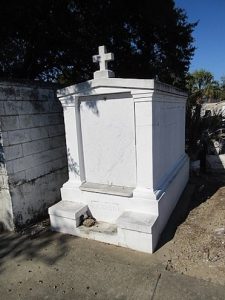4.4 Grave Recycling


Grave recycling is another means by which to help with the problem of limited burial space in cemeteries (Walls et al., 2014). The term applies to several different practices. It refers to the deepening of graves, where bodies are exhumed, graves are made deeper, then bodies are placed back inside, with other bodies placed on top (de Sousa, January 21, 2015; Walls et al., 2014). Grave recycling also refers to the process of exhuming bodies from graves and burying new ones in that cemetery plot. The exhumed remains are then: placed in a mass grave or a common ossuary; boxed and placed in a different part of the cemetery; or cremated and returned to family (Ferraz, July 18, 2018).
The reuse of graves has been going on for thousands of years across many cultures, particularly in Europe (de Sousa, January 21, 2015; Walls et al., 2014). “It is a system that has worked efficiently…all over the world” (de Sousa, January 21, 2015, para. 5). In 19th Century Europe, for instance, families only leased their plot spaces and were allowed to renew those leases after eight to fifteen years if they wished to keep their loved one in that resting space (Uzielli & O’Brien, 2016). In the late 1800s in Portugal, most dead were buried in churchyards until the plot was needed for a new body, at which time the old body would be dug up and placed in a common ossuary. A version of the practice was re-introduced in Portugal in 1962 (Ferraz, July 18, 2018).
As we grapple with issues of burial space, grave recycling is making a comeback in Europe. Although some places still permit perpetual burial plot purchases, there is a trend toward term limited grave/cemetery space rental in most European countries (Hoffner, December 2, 2016). Temporary leases are available for varying periods of time in countries like Germany, Greece, Italy, Portugal, Sweden, Switzerland, and the Netherlands. Depending on the country, leases can last anywhere from 3 to 50 years (Ferraz, July 18, 2018). In Greece, burial plot rentals are usually 3 years in length and prices for extensions are extremely expensive (Hadjimatheou, November 26, 2015). In the UK, some cemeteries are initiating grave recycling practices. For example, the City of London Cemetery has begun reusing burial plots that are at least 75 years of age (de Sousa, January 21, 2015).
Another form of grave recycling occurs in some family tombs, such as those found in New Orleans, Louisiana (see photos at top of page) (Hillinger, 1990). These above ground burial sites typically have 2 shelves, one above the other, that are large enough to hold a casket. Despite their size they can actually house the remains of many family members. The newest casket is always placed on the top shelf and left for a minimum of a year and a day. After that time, when the space is needed for another family member, the casket is removed, the remains placed on the lower shelf, and the casket destroyed (Cemeteries in NO, n.d.). In some tombs, there is space to gather up decomposed remains under the tomb. As space is needed, skeletal remains, ashes, etc. are pushed to the back of the tomb where they fall through a gap into to the space beneath (Atun-Shei Films, January 20, 2019; Hillinger, 1990). Watch the video below to learn more about New Orleans’ crypts.
Click the links below to learn more about burial plot recycling:
Losing the Plot: Death is Permanent, But Your Grave Isn’t
VIDEO: How to Fit 85 bodies in a New Orleans Above-Ground Tomb
The following video provides images and information on the New Orleans Above-Ground Tombs. (Begin watching at 1:04 minute mark).

